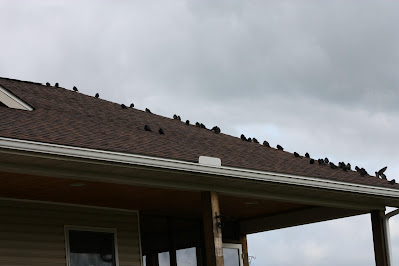This is going to be a totally different post on my nature blog than what you're used to - but I'm finally getting back in my groove, so here goes. I hope you'll be patient with me as I work through this. I spent the last year wrapped up in what was (for me, anyway), a very dramatic change to my life - deciding if / when to retire. Sometimes, the decision process was even driving me to the edge of depression. Along with some physical issues that I needed to resolve, I needed to answer some questions for myself - what would I do if I quit my job? The biggest part of my identity has been wrapped up in my career. I like to be busy and I was very good at what I did - and most importantly, I was very happy at my job. How and why would you quit something you enjoy doing? Finally, I made my decision and I announced it in April, 2024...because I decided there were other things that I would enjoy doing equally as much - probably even more.
Friday, August 2nd, 2024 was my last day as a career woman. I am officially retired! My manager setup a very nice "virtual farewell" party (my colleagues were literally scattered across the globe), and all the warm congratulations and reminiscing of the times we had spent together working on various projects brought tears to my eyes and made my heart ache. But not enough to turn back - I had spent a whole year making this decision and I knew it was the right one for me.
My husband took me out for a very special retirement dinner to celebrate. After working all these years (25 years at this company), and 45+ years total, it felt good to say, "I'm done!". But whew, boy - as my access to the company systems was terminated and I unplugged my computer and turned off my phone, I started to feel really unsteady on my feet. It was strangely unsettling - and it felt like my boat started rocking on some rough seas. I knew that it was not because I was questioning my decision, but something else.
 |
| The train ride I took in Germany and half-way there, realized I was going the wrong direction. Yeah, fun times! |
I stood on my front porch Friday evening and tried to sort through all these new (and surprising) emotions. As I listened to the indigo buntings chirping to each other from the various treetops, (apparently, I have a huge flock of them here), the Bob-white quail calling, a particularly loud Dickcissel and the hot breeze baking my face, I finally realized I was not really 'looking' at the landscape. I started to focus my eyes on my prairie and the flowers blooming, my new bird bath, my garden that needs tending and all the other things that I WANT to engage in now. I realized, I had lost my "working-woman" rhythm. I have had a 5-day workweek with a purpose and a rhythm with a known schedule for the weekends for many, many years. Now my tether was gone and I felt like I was flapping around out here in the wind without an anchor.
 |
| A Dickcissel checks out the birdbath and tries to decide whether he can trust me. |
Saturday, I packed up all the work equipment into my FedEx box and rearranged my desk - another step of closure. I turned my work phone back on to make sure I had it properly set to go and ensure there were no messages waiting for me. A message appeared to let me know I was no longer allowed any access to anything. WELL....I guess I really am done!
 |
| My trip to Salzburg, Austria - yeah, we're gonna climb that hill in the background up to that castle. HA! |
 |
| Salzburg, Austria - we made it! |
I puttered around the house Saturday. One of my goals for my first week was to clean out my closet - specifically, to get rid of some of the work clothes that I will likely never wear again. I had confidently told myself, THAT task should be easy. But, as I previewed the job, I realized this was going to be a very emotional task. Just too many memories tied to these clothes - I remember wearing that skirt in Germany and that outfit when I toured Salzburg, Austria on a 2-week work trip, etc., etc. My heart started to ache again.....NOPE, nope, nuh-uh, I can't do this yet.
 |
| My first trip to Germany - my German ancestor's cellar! |
 |
| Trip to Munich, Germany - King Ludwig's Palace |
Sunday, I decided to clean out my bird bath before the mosquito larvae grew into adult mosquitos! Dang, it's SO hot...I told my husband, I should have waited another month or two to retire, so the weather would have been cooler and I could get outside more to vent these emotions. But, as my husband said, "you could have played that game for years, and never retired".
Today, Monday, August 5th, I realized the first benefit of retiring - no more "Ugggghhhh, it's Monday!" for me! And no more alarm clocks...unless I want to set one.
I'm still feeling a bit unsteady today, so, for now, I'm trying to take it easy for the first week. Eventually, I'll find all the pieces to put into place so I can establish a new rhythm - a fun, "NOW, I get to do ANYTHING I want to", rhythm. And steady my ship once again.
 |
| Me - on a trail cut thru our Tall Grass prairie. |
 |
| Our piece of heaven - Gobbler's Knob |






.JPG)
































